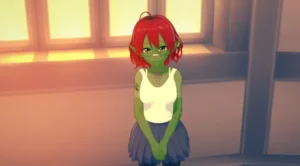
Tales of Unity
Play Tales of Unity
Tales of Unity review
Exploring the narrative and gameplay elements that set Tales of Unity apart
Tales of Unity offers a distinctive experience in the realm of visual novels, blending mature themes with a compelling story that goes beyond typical genre expectations. This game stands out by weaving its narrative and character development seamlessly with its gameplay, creating an immersive experience that rewards players with meaningful choices and rich storytelling. If you’re curious about what makes Tales of Unity unique and how it integrates its themes thoughtfully, this article will guide you through the game’s core aspects and what to expect.
Narrative Depth and Story Integration in Tales of Unity
When you first boot up Tales of Unity, it’s easy to think you’re in for a standard fantasy adventure. I certainly did. But within the first hour, the game completely subverts those expectations, pulling you into a world where every dialogue choice feels weighted and every character glance holds meaning. This isn’t a story you watch; it’s a story you live and breathe. The Tales of Unity story is the engine of the entire experience, a masterclass in visual novel storytelling that refuses to be a passive backdrop. 🎮
What sets this game apart is its unwavering commitment to making the narrative the central pillar. Your decisions don’t just alter a morality meter tucked away in a menu; they actively reshape relationships, open or close entire story branches, and determine which allies stand with you in the final hour. The Tales of Unity narrative integration is so seamless that you stop thinking of “gameplay” and “story” as separate things. They are one and the same.
How the Story Drives the Gameplay Experience
In many games, the narrative feels like a reward for getting through the gameplay sections. “Sit through this combat encounter, and you’ll get a cutscene!” 🎭 Tales of Unity flips this script entirely. Here, the Tales of Unity gameplay story is a continuous, unbroken thread.
I remember a specific moment about halfway through my playthrough. I was faced with a crucial decision during a tense negotiation. The “gameplay” was simply choosing a dialogue option, but the stakes felt incredibly high. My choice didn’t just result in a different line of text; it directly influenced the next story mission, changing the objectives, the enemies I faced, and even the tools at my disposal. A diplomatic success meant a stealth-based infiltration mission, while a failed negotiation led to a desperate, large-scale battle. This is the core of the Tales of Unity story—it’s the map that dictates your journey, not just the scenery you pass by.
The game brilliantly uses its narrative to teach you its mechanics. You don’t get a tutorial pop-up about a new combat skill; instead, a character teaches it to you in a moment of vulnerability, weaving the lesson into their personal arc. This approach makes learning feel organic and meaningful. You’re not just gaining a new ability; you’re inheriting a part of their story. ✨
Pro Tip: Pay close attention to seemingly minor dialogue choices. The game remembers everything, and a throwaway comment in Chapter 2 might unlock a vital story path or character scene in Chapter 6.
Character Development and Unique Interactions
If the story is the heart of Tales of Unity, then the characters are its soul. The Tales of Unity character development is some of the most nuanced I’ve ever experienced. Each companion is a complex tapestry of motivations, fears, and past traumas, and the game gives you the time and space to unravel them.
This is where the unique character scenes Tales of Unity offers truly shine. These aren’t generic “loyalty missions.” Each scene is meticulously crafted to reflect a specific character’s personality and history. For one character, a “scene” might be a quiet, philosophical debate under the stars. For another, it could be a chaotic bar fight that reveals a hidden protective streak. 🍻
I was particularly moved by a scene with the character Kaelen, a seemingly stoic knight. Instead of a grand battle, his pivotal scene involved him quietly repairing a child’s broken music box. This simple, intimate moment told me more about his character—his patience, his hidden gentleness, his grief for a lost childhood—than any epic monologue ever could. These scenes are voluntary; you have to seek them out by building trust. Finding them feels like discovering hidden treasure, and each one adds a crucial piece to the overarching Tales of Unity story.
The following table highlights how different character scenes contribute to the overall narrative:
| Character | Unique Scene Focus | Narrative Impact |
|---|---|---|
| Elara | Confronting a political rival from her past | Unlocks new dialogue options for diplomatic quests and alters her combat style to be more assertive. |
| Ryn | Visiting the ruins of his childhood home | Reveals a key piece of world-history lore and provides a permanent stat boost against a specific enemy type. |
| Maeve | Helping her reconcile with a estranged sibling | Transforms her role in the party from a lone wolf to a strategic leader, enhancing support abilities for all members. |
The Role of Mature Themes as Storytelling Elements
Many games use mature content for shock value, but Tales of Unity incorporates its mature themes in Tales of Unity with purpose and grace. The game isn’t afraid to explore difficult subjects like systemic oppression, the psychological toll of war, and the gray areas of morality. These aren’t edgy decorations; they are fundamental to the Tales of Unity character development and the world’s fabric. 🌑
The handling of mature themes in Tales of Unity is what elevates it from a great game to a memorable one. For instance, a major arc deals with the cycle of revenge. The game doesn’t present a clear “good” or “bad” side. Instead, it forces you to listen to the grievances of both, making your final choice agonizingly difficult. Your decision here has lasting consequences, affecting your party’s morale and the world state in the endgame. This is a prime example of the powerful Tales of Unity narrative integration.
Furthermore, these themes are often the key to unlocking the deepest layers of your companions. You earn their trust not by giving them gifts, but by proving you understand their struggles and respecting their boundaries. The “reward” for engaging with these heavy topics is a richer, more emotionally resonant connection to the world and its people. It makes the final act of the Tales of Unity story feel profoundly personal. 💔
The Tales of Unity gameplay story loop is a virtuous cycle: the deep narrative makes you care about the characters, your care for the characters drives you to engage with the mature themes, and understanding those themes empowers you to make more informed, impactful decisions that further shape the narrative. It’s a brilliantly designed system that proves just how powerful and emotionally engaging a video game story can be when every element is unified in purpose. 🏆
Tales of Unity offers a refreshing take on visual novels by prioritizing story and character depth alongside its gameplay. Its thoughtful integration of mature themes enriches the narrative without detracting from the overall experience. For players seeking a game that balances storytelling with engaging interactions, Tales of Unity is a compelling choice. Dive in and explore the unique world it presents—you might find it more rewarding than expected.








